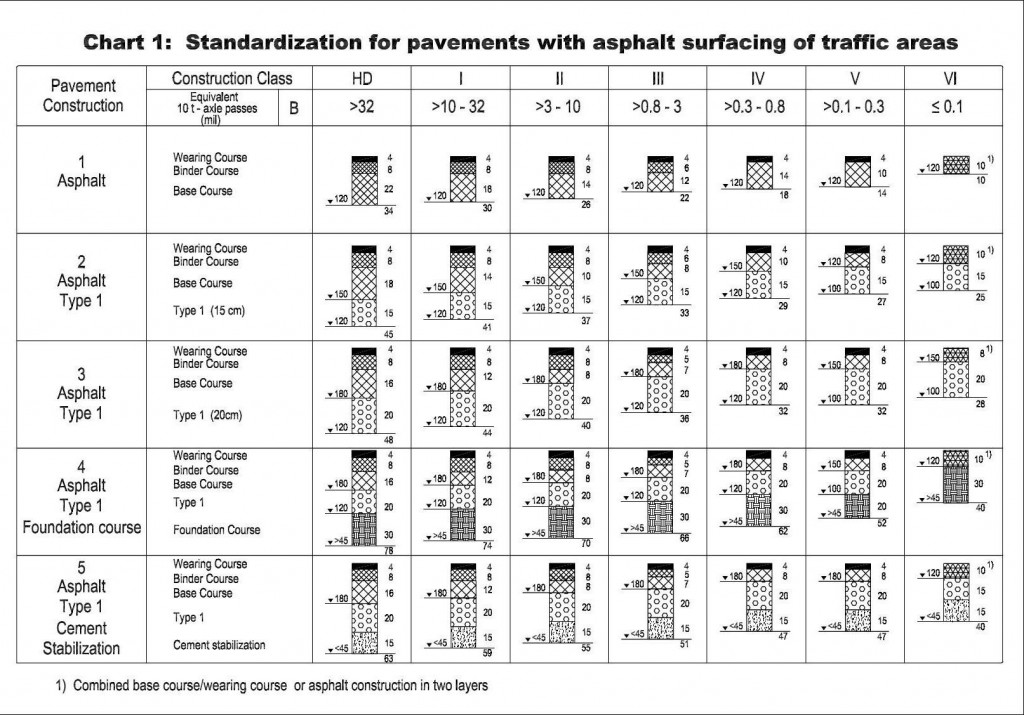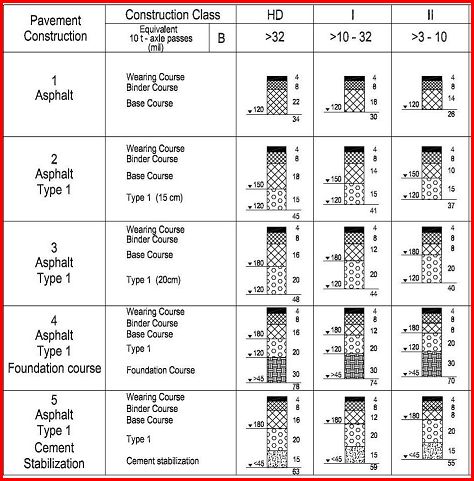The Road Structure Catalog
Post written by Perit Mark John Scicluna.
No Need to Panic
Designing roads is similar to designing any other structural element. First, one must determine the loads which the building is being subjected to, and according to these loads and other safety factors beams, columns and slabs are sized accordingly.
If the beam is subjected to loads which it has been designed to cater, it will perform satisfactorily. If the beam is subjected to loads considerably higher than the factored design loads, it wall inevitably fail.
Similarly, just as beams and columns are designed according to the loads they are designed to take, roads too as structural elements have to be designed according to the loads they are subjected to. The loads on roads depend on the number of vehicles passing over them.
Engineers usually use software or tables to size beams. Similarly road engineers have devised tables to assist them in the selection of the most appropriate road structure according to the number of equivalent 10t axles passes. This is known as the Road Structure Catalog and is shown in the chart below.
Road Construction Classes
The Road Structure Catalog consists of 7 columns denoting the road construction classes. The classes vary from HD to Class VI with HD being the top of the range road structure while Class VI being the typical road structure in villages and cities. These road classes are classified according to the number of the equivalent 10t axle passes.
- Class HD can cater for an amount greater than 32 million equivalent 10t axle passes
- Class I can cater for 10 to 32 million equivalent 10t axle passes
- Class II can cater for 3 to 10 million equivalent 10t axle passes
- Class III can cater for 0.8 to 3 million equivalent 10t axle passes
- Class IV can cater for 0.3 to 0.8 million equivalent 10t axle passes
- Class V can cater for 0.1 to 0.3 million equivalent 10t axle passes
- Class VI can cater for less than 0.1 million equivalent 10t axle passes
Construction Type of Road Structures
For each class the Road Structure Catalog specifies 5 different types of construction depending on the available depths of the road structure and the bearing capacity of the underlying material. The 5 different types of construction have similar performances for each class.
For example for Class I, Type 1 to 5 perform similarly and are all adequate to sustain 10 to 32 million equivalent 10t axle loads. The depth of road structure depends on:
- the location of underground services
- and the type of sub grade material.
- Construction Types 1 to 3 cater for subgrades with Ev2 greater than 120.
- Construction Type 2 and 3 also cater for subgrades with Ev2 greater than 100.
- Construction Types 4 to 5 cater for subgrades with Ev2 less than 45.
Ev2 is the result of the second loading of the plate bearing test.
Materials used as part of the Road Structure Catalog
The basic materials forming the road structures listed in the catalog are:
- asphalt wearing course
- asphalt binder course
- asphalt base course
- asphalt combined base / wearing course
- cement stabilisation
- type 1 material
- foundation course
- subgrade
Pavement Construction Type 1 – Road Structures on good subgrade (With depth restrictions)
This type is suitable for roads on good sub grades, having an Ev2 greater than 120. The maximum depth for this road structure varies from 340mm for Class HD to 100mm for Class VI. The materials used for this type of construction are wearing course, binder course and base course.
Pavement Construction Type 2 – Road Structures on good subgrade (With depth restrictions)
This type is suitable for roads on good sub grades, having an Ev2 greater than 120. The maximum depth for this road structure varies from 450mm for Class HD to 250mm for Class VI. The materials used for this type of construction are wearing course, binder course, base course and 150mm of Type 1.
Pavement Construction Type 3 – Road Structures on good subgrade (With no depth restrictions)
This type is suitable for roads on good sub grades, having an Ev2 greater than 120. The maximum depth for this road structure varies from 480mm for Class HD to 280mm for Class VI. The materials used for this type of construction are wearing course, binder course and base course.
Pavement Construction Type 4 – Road Structures on poor Subgrade (No depth Limitation)
This type is suitable for roads on poor sub grades, such as clays. The maximum depth for this road structure varies from 780mm for Class HD to 400mm for Class VI. The materials used for this type of construction are wearing course, binder course, base course, Type 1 material and a foundation course.
Pavement Construction Type 5 – Road Structures on poor Subgrade (With Depth Limitation)
This type is also suitable for roads on poor sub grades, such as clays. The maximum depth for this road structure varies from 630mm for Class HD to 400mm for Class VI. The materials used for this type of construction are wearing course, binder course, base course, type 1 and cement stabilisation.
Classes HD, I and II
The different types of pavement construction in each column perform similarly. Hence, for example the road structure for the HD class varies from 340mm for Type 1 to 630mm for Type 5. Pavement Construction Type 5 is more expensive than that of Type 1.
Classes III, IV, V, VI
These are the most commonly used Classes, with Class V and VI being the most commonly used pavement construction for Local Council Roads.
Construction Class 6 indicates that an asphalt combined base wearing course is used instead of the traditional asphalt base and wearing courses.
Categories: Road Engineering
Tags: Road Engineering
Comments: No Comments.








